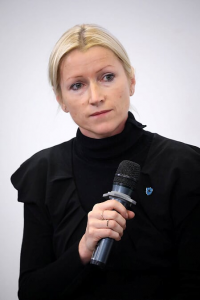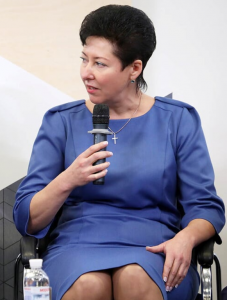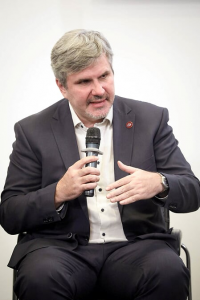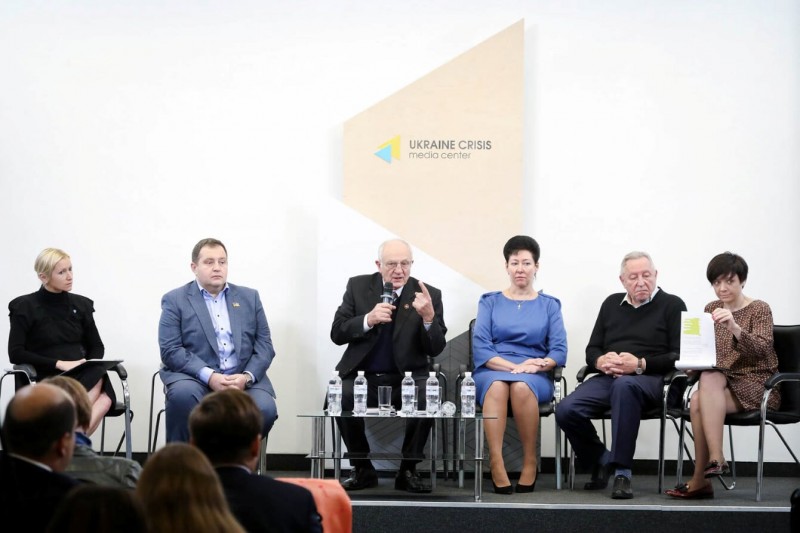 Kyiv, October 10, 2019– On the eve of World Stroke Day, representatives of the Ukrainian Parliament’s Committee on National Health, Medical Assistance and Health Insurance, National Health Service of Ukraine (NHSU), professionals providing Stroke Care to patients, and members of the public discussed what should be done by the state to ensure the availability of high-quality Stroke Care in order to reduce the mortality and disability from cerebrovascular disease.
Kyiv, October 10, 2019– On the eve of World Stroke Day, representatives of the Ukrainian Parliament’s Committee on National Health, Medical Assistance and Health Insurance, National Health Service of Ukraine (NHSU), professionals providing Stroke Care to patients, and members of the public discussed what should be done by the state to ensure the availability of high-quality Stroke Care in order to reduce the mortality and disability from cerebrovascular disease.
 The new Cabinet of Ministers of Ukraine, which has pledged to continue reforming the health care system, recently promulgated a Program where it set an ambitious goal of reducing the mortality rate by 5%. It is impossible to achieve this goal without creating a system of high-quality medical care for patients with acute stroke, as stroke is one of the leading causes of premature mortality and acquired disability in Ukraine.
The new Cabinet of Ministers of Ukraine, which has pledged to continue reforming the health care system, recently promulgated a Program where it set an ambitious goal of reducing the mortality rate by 5%. It is impossible to achieve this goal without creating a system of high-quality medical care for patients with acute stroke, as stroke is one of the leading causes of premature mortality and acquired disability in Ukraine.
In 2018-2019, Ukraine has taken the first steps towards creating a National Stroke Strategy. The Working Group, established by the order of the Ministry of Health (MOH) of Ukraine, has drafted the Stroke Action Plan in Ukraine for 2020-2030 and the Provisions on the network of healthcare facilities assisting patients with acute stroke specifying the requirements the hospitals are to meet. As of 2020, these services will be covered at the higher rates by the NHSU under the Guaranteed Medical Services Program. In addition, the MOH, together with the experts of the Working Group, collected information about the departments admitting acute stroke patients throughout the country. The experts were unanimous in that for our country the price of inactivity in this area far exceeds any costs of the right measures, any delay is unacceptable and it is to go ahead with the work started.

Prof. Mykola POLISHCHUK
“There are about 150,000 strokes every year in Ukraine. Many stroke patients are now being treated in general neurological or even therapeutic wards. This is unacceptable, and we request the local departments of health and hospital authorities change this situation as soon as possible, allowing stroke patients to be admitted only to specialised stroke wards. Research and real-world evidence in many countries around the world have shown that care provided in Stroke Units and Stroke Centers significantly reduces stroke mortality and morbidity as well as disability after stroke. According to the preliminary results of our data analysis, out of more than 500 wards admitting stroke patients in Ukraine, less than half have the necessary equipment for the diagnosis and treatment of stroke.
They are unable to perform the necessary workup and to carry out the necessary interventions. Up to 30-40% of stroke patients in Ukraine die within 1 month from the onset and less than 20% ever return to their previous level of daily activities. Our aim is to make sure that most of them reintegrate to the society and continue to live their life, ”- said Prof. Mykola POLISHCHUK, Neurosurgeon, the President of the NGO “Ukrainian Anti-Stroke Association”.

Dr. Maxim PEREBIYNIS
Dr. Maxim PEREBIYNIS, Subcommittee Chair, Ukrainian Parliament’s Committee on National Health, Medical Assistance and Health Insurance, answered the questions about the next steps the state needs to take in order to control stroke: “At the level of the Government, the Parliament and The President’s Office we are working to develop a program aimed at setting up a network of specialized stroke centers in Ukraine, with the involvement of the World Bank.
There are hospitals that already have trained doctors and necessary facilities, but many more are needed. However, a lot of work has yet to be done to properly plan the network of stroke centers, which should be located so that patients are delivered to the hospital on time (transportation should take less than 60 minutes).
To start with, it is necessary to analyze the existing institutions, technical and human resources in order to properly plan the network of these centers. Luckily, we don’t have to “reinvent a wheel”, we just need to implement what works well around the world. ”

Prof. Serhiy MOSKOVKO
Professor Serhiy MOSKOVKO, Neurologist, scientific adviser to Stroke Unit at Vinnytsia Oblast Psychoneurological Hospital, member of the Working Group under the MOH of Ukraine: The Working Group has drafted requirements for health care facilities that provide medical assistance for acute stroke. Compliance with these requirements demonstrates the hospital’s ability to provide high-quality stroke care. Overall, these requirements are an based on the requirements by the European Stroke Organisation adopted in many European countries. With institutions that meet these requirements, the NHSU will sign appropriate contracts in 2020 and will pay for the treatment of patients with stroke at an increased rate under the Guaranteed Medical Services Program.
We very much look forward to understanding and cooperating with the new team at the MOH of Ukraine. Our common goal is to make sure that every stroke patient in Ukraine has access to high-quality care and that hospitals that can provide such effective care have adequate supply for all the essentials, including alteplase, the drug for thrombolytic therapy. We need to significantly increase the number of thrombolyses in the country, then this will affect public health and mortality rates. For example, there are over 25,000 thrombolitic treatments performed in Poland per year compared with only 400 in Ukraine.

Mrs. Oksana MOVCHAN
Deputy Head of the NHSU Mrs. Oksana MOVCHAN told how the NHSU will fund the delivery of medical care to patients with acute stroke starting in April 2020: “In 2020 the tariff is going to be UAH 19,500 (about €720) per case. The tariff covers the workup for verification of the diagnosis, necessary care, medications from the National Essential Medicines List, excluding drugs provided through the government or local programs (such as thrombolytics), and acute rehabilitation. This tariff is almost three times as high as was paid under the medical subvention. We plan to arrange emergency medical services to deliver stroke patients only to those hospitals where they can receive timely and quality care.”
Mrs. MOVCHAN also emphasized that only hospitals that meet the requirements for acute stroke care will be able to receive payments from the NHSU at an increased rate. They are supposed to have all the necessary equipment and specialists to timely diagnose and treat stroke, in particular the equipment for neuroimaging: CT and / or MRI. The NHSU will not only pay for the service, but also monitor whether or not the hospitals comply with the terms and conditions of the contract. “In particular, this care package is absolutely free of charge for the patient, and hospitals cannot charge patients or families for this service,” Mrs Movchan said.
 Dr. Lyudmila LYPOVENKO, Head of the Neurological Department, the Second City Hospital in Bila Tserkva, shared her vision of the situation at the regional level: “As early as 2011, we began to perform systemic thrombolysis and have appreciated the difference between modern and old stroke care. In 2016, we set up a modern Stroke Unit with all the equipment and a multidisciplinary team. Now all stroke patients from Bila Tserkva and surrounding villages are referred to our hospital. A stroke patient who is a candidate for thrombolysis, bypasses the emergency department and goes directly to the CT scan, where the treatment is started immediately. We have done a lot to properly organise care pathways, however at times we are still facing a lack of thrombolytics provided by the state or local government. In 2019, we performed thrombolytic therapy in 55 patients, although according to the state program, we received the drug for only 10 cases. ”
Dr. Lyudmila LYPOVENKO, Head of the Neurological Department, the Second City Hospital in Bila Tserkva, shared her vision of the situation at the regional level: “As early as 2011, we began to perform systemic thrombolysis and have appreciated the difference between modern and old stroke care. In 2016, we set up a modern Stroke Unit with all the equipment and a multidisciplinary team. Now all stroke patients from Bila Tserkva and surrounding villages are referred to our hospital. A stroke patient who is a candidate for thrombolysis, bypasses the emergency department and goes directly to the CT scan, where the treatment is started immediately. We have done a lot to properly organise care pathways, however at times we are still facing a lack of thrombolytics provided by the state or local government. In 2019, we performed thrombolytic therapy in 55 patients, although according to the state program, we received the drug for only 10 cases. ”
Main Points:
• Every year, about 150,000 strokes occur in our Ukraine.
• Stroke and cerebrovascular disease are the second cause of death (more than 100,000 deaths per year or 13-15% of all deaths) and the leading cause of acquired disability in adults.
• Stroke mortality in Ukraine is several times higher than in Western Europe.
• High-qualitative stroke care is inaccessible, and 30-40% of stroke patients die within 1 month of onset.
• Stroke can strike at any age, and one third of stroke patients in Ukraine are people of working age.
• Ukraine has endorsed the European Stroke Action Plan for 2018-2030 and is moving towards a national stroke strategy aimed at reducing the burden of the disease.
 Thus, taking into account the Ukrainian Government’s Action Plan goal to reduce the mortality rate along with the epidemiological situation in Ukraine, we emphasize the urgent need to create in Ukraine a network of healthcare facilities that provide assistance to patients with acute stroke (120-150 Acute Stroke-Ready Hospitals or Stroke Units and 40-45 Stroke Centers).
Thus, taking into account the Ukrainian Government’s Action Plan goal to reduce the mortality rate along with the epidemiological situation in Ukraine, we emphasize the urgent need to create in Ukraine a network of healthcare facilities that provide assistance to patients with acute stroke (120-150 Acute Stroke-Ready Hospitals or Stroke Units and 40-45 Stroke Centers).
In order to provide high-quality care, timely imaging of the brain, its vessels and the heart as well as laboratory tests and evidence-based treatment, including IV thrombolytic therapy (if not contraindicated), should be guaranteed to all acute stroke patients.
This approach will reduce the burden of stroke for individuals, their families, local communities and the state as a whole.


Dr Marina GULIAIEVA, Ukrainian Anti-Stroke Association

Dr Dmytro LEBEDYNETS and Dr Mychilo Tonchev

Dr Yuriy FLOMIN, Ukrainian Anti-Stroke Association





